Introduction:
People are an essential part of dental practice. The most important person in a dental practice is the patient. For health care professionals in India, advertising has traditionally been seen as a controversial issue, and the notion of using advertisement to promote a professional practice is relatively new. In India, the rules governing the advertisements by dentists are clear and definite. In the Dentists (Code of Ethics) Regulations 1976, advertising, “whether directly or indirectly, for the purpose of obtaining patients or promoting his own professional advantage,” (h) or “acquiescing in the publication of notice commending or directing attention to the practitioner’s skills, knowledge, service or qualifications, or of being associated with or employed by those who procure or sanction such advertising or publication through press reports” (i) is defined as unethical, equal to the “conniving at or aiding in any kind of illegal practice” (f).[1] Under the code of ethics, any advertisement by dentists should be limited to the announcement of the opening of a practice, a change of address, a change of ownership, or the introduction of a new associate or partner.[1]
Although advertising is prohibited in India, a number of countries have permitted dental advertisement. Now, several countries such as Australia, USA, UK and New- Zealand enjoy open publicity for promotion and advertisement by medical professionals. However, despite this world-wide phenomenon of deregulation, India has been standing strong over this issue, not allowing any dentists to advertise their services.
Despite these rules, a number of practitioners ignore the code of ethics to advertise their services. Many dentists feel that advertising is a necessary part of running a business, and some argue that it has the potential to be beneficial. Supporters of advertising claim that informative advertising can empower consumers to make good decisions regarding their oral health; increase the community’s awareness of dental health care; encourage better quality dental services by dental suppliers; decrease unemployment in the industry; and help consumers choose a dentist. However, there are also those who defend the traditional view that dentistry is primarily a health profession not a business, and that the ethical considerations of a practice should be paramount.
Public attitudes toward advertising have been of interest to advertising researchers for years. Attitude towards advertising has been defined as “a learned predisposition to respond in the consistently favorable or unfavorable manner to advertising in general”.[2] Earlier studies (until the early1960s) measured general advertising attitudes as an “overall favorable or unfavorable”. Bauer and Greyser (1968)[3] suggested that advertising had important economic and social effects, and developed a set of belief items related to positive and negative outcomes of advertising in these two specific areas.
Today, dentists across the country have realized that in a competitive, consumer-oriented society, they must become involved in marketing to increase their practice. Marketing is advertising and all dentists practice some form of advertising. Marketing can be divided into two forms-internal and external. Internal marketing is what one does within the clinic to retain patients. External marketing involves strategies’ done outside the clinic to attract and retain patients, which extends from simple lectures to complex as media advertisement. Studies have shown that dentists should consider the use of internal communications, such as the practice brochure, business cards, in-house information centers, thank you notes, and direct mail to patients,[4] as effective alternatives to advertising. The aim should be to communicate the clinic’s services in a patient-specific, caring tone, rather than an impersonal message directed at a mass of consumers.[5] sparse literature is available regarding the public attitude towards dental advertisement. This provided an impetus to determine the consumer’s attitudes towards the dental advertisement in various cities of Maharashtra, India.
Aim:
The aim of this study was to investigate the attitudes of public towards dental advertisement in Maharashtra, India.
Objectives:
h8707; To identify the views of public on the effects of advertising in dentistry
h8707; To identify the stances of public on dental advertisement
h8707; To study the relationship among the respondents’ backgrounds, stance on dental advertisement and views on the effects of advertising
Methodology:
The present study is a descriptive cross sectional survey, conducted to assess the general population attitude towards dental advertisement between age group 16 and above spread across the various cities in the Maharashtra, India. Permission was obtained from the ethical review board of ACPM Dental College and Hospital, Dhule, to conduct the survey. Written informed consent was obtained from the study participants before the questionnaire was distributed. For the illiterates questions were read and explained by the investigator and their thumb impression was obtained as consent.
A self designed structured questionnaire was prepared in the local language (Marathi) based on previous studies, investigators own observation and on objectives of the current study. Questionnaire consisted of
1) Demographic details which included education level of participants, income, and occupation. Socio economic status was measured using B.G.Prasad classification.
2) First part questionnaire, included questions to assess respondents view towards dental advertisement and responsibility of dental profession and dentist
3) Second part consisted of questions to assess the influence of celebrities, children, media, in deciding dentist and dental treatment.
4) Third part of questionnaire focused on assessing public opinion about claims of dentist regarding various treatment, success, and image of dentistry.
Questionnaire validity was checked by Chronbach’s alpha (0.8). Pilot study was carried out on 100 subjects covering various part of dhule city to check the feasibility and validity of questionnaire before the final survey. Based on the pilot study final sample size was determined
The data was collected from various cities of Maharashtra state to obtain a fairly representative sample and all sections of society. The questionnaire was distributed randomly to those who were relatively free and sufficient time was given to read and complete the questionnaire. For illiterates questionnaire was read and investigator helped to complete the same. The participants were requested to answer the questions with interest and concentration to obtain a valid result. Sufficient time was given to complete the questionnaire and collected on the same day. The data was compiled and subjected to chi-square test using SPSS software (version 16).
Results:
Total 583 people participated in the survey, among them 377 (64.7%) were males and 206 (35.3%) were females. Participants were from 16 to 85 years age group, Majority belonged to 16 to 35 years age group (16-25 age group 30.9%, 26-35 age group 34.9%). High school and under graduate level of education was the qualification of majority subjects (36.4% and 33.1% respectively). More percentage of the people was professionals (37.6%) and belonged to upper high socio economic status (48.5%). Overall, (39.6 %), agreed to the questions in the questionnaires, (Table 1). (Table 2), depicts the response of participants in relation to gender, majority of females 44.2% agreed to the questions and around 37% males agreed to the questions. (Table 3), represents the correlation of age and public opinion, proportion of the participants agreeing increased as the age increased which was statistically significant (p =0.00). As the level of education of the participants increased, proportion of the participants response was agreed, it was statistically significant with (p value = 0.002. (Table 4). (Table 5), shows the correlation between occupation and response with more proportion of professionals and skilled people agreeing to the questions. It was statistically significant (p = 0.006). (Table 6), shows the correlation between socioeconomic status and public opinion , upper and middle class people major response was agreed to the questions, it was statistically significant (p = 0.00). (Table 7), shows the response about the dentist advertising to create awareness, various methods for advertising and treatment facilities available and opinion about dentists advertising. It was statistically significant. (Table 8), shows the response of participants on the influence of recognized bodies to buy dental products.
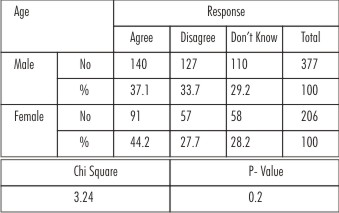 | Table 2 : Gender Wise Distribution Of Study Participants
 |
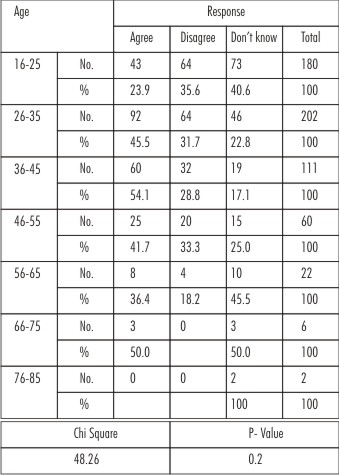 | Table 3 : Distribution Of Participants Based On Their Age And Response
 |
 | Table 4 : Distribution Of Participants Based On Their Level Of Education And Response
 |
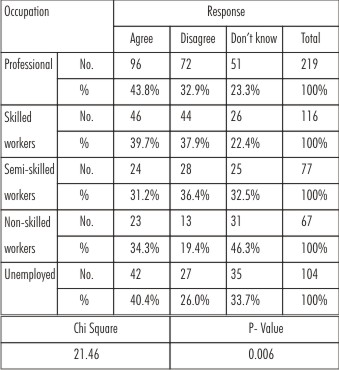 | Table 5 : Distribution Of Participants Based On Their Occupation And Response
 |
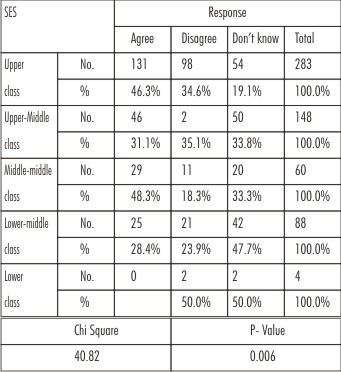 | Table 6 : Distribution Of Participants Based On Their Socioeconomic Status (SES) And Response
 |
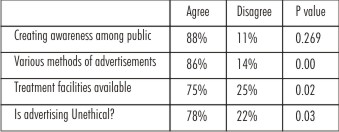 | Table 7 : Distribution Of Participants Based On Their Response And Different Parameters
 |
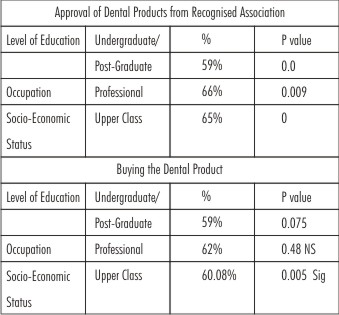 | Table 8 : Response Of The Participants Towards Different Variables
 |
Discussion:
Marketing has become an essential component for success in business. Effective marketing comprises of different techniques like push and pull strategies. Advertisement aptly can be classified under push strategy. Majority of non-professionals rely on various marketing technique to promote their business and products, of late marketing has carpeted into medical and dental profession to promote their products and it is important to explore exactly what is consumers’ opinion towards advertisement in dental profession.
The present study was an initial step in developing a better understanding of how advertisements influence cognitive and effective responses of Maharashtra, India public randomly selected from different cities.The present survey proves that more than half of the respondents are in favor of advertising by dental professionals in India.In the present study around 40 % (Table 1) of respondent were attracted to advertisement, this, probably technology has made easy to reach out public in an effective way. Although other studies suggested that advertisement were either easily ignored by the audience, or were perceived to have little value.[6], [7]
It was observed, females (44.2%) were more affected by advertisement than male (37.1%) (Table 2). This could be because females remember more facts, make more inferences, report stronger emotional responses’, and detect the explicit claim of the advertisement more frequently than male.[8] the study also showed that influence by advertisements in dental profession increases with increase in age,(Table 3) probablyenabling the individuals’ wisdom to judge the information more wisely. Level of Education enables the person to evaluate and criticize the information, highly educated people were more logical about what they perceive and purchase from commercial advertisement. This was evident in our study findings (Table 4) as graduates and post graduates had positive image towards dental advertisement. In our study, People in upper socioeconomic class had been positively influenced by advertisement compared to lower socioeconomic class, perhaps level of education and income, might have influenced the individuals attitude towards understanding and deciding the worth of the advertised product. (Table 6)
Majority of Graduates and post graduates opined, advertisements helped in creating awareness about dentistry.(Table 7) It was also found in the present research, that TV advertisements were the most attractive advertisements media (80%), these finding support findings of other studies [9], [10], [11], [12] where they reported that TV is the premier and the fastest growing advertising media today. TV has many advantages, first its’ persuasive influence on consumers’ taste and perception .Second, it can reach a large audience in a cost efficient manner. Third, the strong impact is created by the sound and moving images.
When data was analyzed considering all the demographic parameters into account, it was seen majority of people agreed that advertisement done by dentist, positively affects the image of dentist and dental profession, Probably level of education, income and occupation of the participants are important for their attitude towards dental advertisement. (Table 7) Unethical advertising is neither appreciated nor condoned, but there is a demand for relaxation in the restrictions, which would be beneficial in helping upcoming dentists to establish themselves in a competitive industry.
Analyzed data showed, more than 60% of respondents from different occupational groups were motivated to buy the product when recognized Dental Society recommends it. (Table 8) One of advertisement function is influential, the advertisement changes the purchasing behavior.[13],[14] if the advertisement is sufficiently entertaining, and the customer may remember it. However the customer may then learn that the advertisement relates to personal need and provides relevant and valuable information for that need[11], thus Consumers get more interested in the advertisements and try to change their regular habit especially when a dentist or recommendations of the Dental Society accompany the advertisements. Advertising as a valuable source of information was also reported by Singh & Vij (2007).[12]
The relationship between cognitive and affective responses and consumer purchasing is complex. But, we should be aware of the influence of advertisements on our society. We suggest having a number of educational groups to control or restrain negative advertising, also, consumer education and media literacy programs that emphasize techniques used by advertisers. In conclusion, the overall analysis which included various demographic and socio economic aspects of advertising reveals that public is highly critical of social aspect; in addition, the present study provides direct evidence of the effect of advertisements on the consumer response toward dental products. Further studies should also incorporate the use of Artificial Neural Network (ANN) which is an intelligent system used as a model to measure attitude towards advertising.[15]
Acknowledgement:
The authors would like to thank all the participants for their kind cooperation and support during tenure of the study.
References
1. Ministry of Health and Family Planning, Department of Health. Dentists (Code of Ethics) Regulations. Part II, Section 3, 6(h–o). New Delhi: The Gazette of India; 1976:2223 –7.
2. Lutz R. Affective and Cognitive Antecedents of attitude towards the ad: A conceptual framework; in psychological processes and advertising effect at theory/ Research and Applications, L. Alwitt and A. Mitchell, eds., Hillsdale, NJ: Erlbaum. 45-63
3. Bauer R. and Greyser S. Advertising in America; the Consumer view, Boston; HarvardUniversity Press. 1968
4. Nacht ES, Trupkin D. 15 internal marketing tools that will improve your practice of pediatric dentistry.J Clin Pediatr Dent:1993; 18(1): 1–2.
5. Ashford RA. An investigation of male attitudes toward marketing communications from dental service providers. Brit Dent J: 1998; 184(5): 235–238.
6. Bogart, L. War of the words: Advertising in year 2010 across the board. Proceeding of the 2000 Conference of the American Academy of Advertising, 2000
7. Wang CH., Zhang P., Choi R., D’Eredita M. Understanding consumers’ attitude towards advertising. English American Conference on information system 2002
8. Edens K M, McCormick CB. How do adolescents process advertisements? The influence of Ad characteristics, processing objective, and gender. Contemp Educ Psychol2000; 25; 450-463.
9. Yang KCC. The influence of human navigation interface on users’ responses to internet advertising. Telematics and Informatics 2006; 23(1); 38-55.
10. Moon BJ, Jain SC. Consumer processing of foreign advertisements; roles of country-of-origin perceptions, consumer ethnocentrism, and country attitude. International business review 2003 11 (2), 117-138.
11. Ramalingam V, Palaniappan B, Panchanatham N, Palanivels. Measuring advertisement effectiveness-a neural network approach. Expert systems with applications 2006; 31(1) : 159-163.
12. Singh R. Vij S. Socio-Economic and Ethical Implications of Advertising – A Perceptual Study Social Responsibility, Ethics & marketing International Marketing Conference on Marketing & Society, 8-10 April, 2007, IIMK
13. Bush A., Smith R., Martin C. The influence of consumer socialization variable on attitude toward advertising: A comparison of African-American and Caucasians. Journal of Advertising; 1999, 28: 3, 13-24
14. Defleur ML Dennis EE. Understanding mass communication, Houghton, Millen company, Boston, M A(1996).
15. Venayagamoorthy GK, Moonasar V, Sandrasegarah K. Voice recognition using neural network, IEEE 1998,PP.29-32. Full text via cross Ref/view Record in Scopus/cited by in Scopus.
|